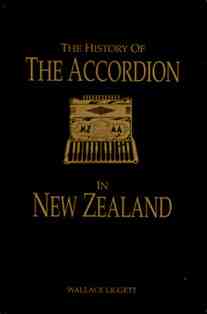
Chapters:
The History of The Accordion in New Zealand
Chapters:
Published in 1993
Publisher: New Zealand Accordion Association Inc.
4 O'Neills Avenue
Takapuna, Auckland 9
New Zealand
Phone: (9) 489 8316
E-mail: bellows@accordions.com
Review by Henry Doktorski:
Proportionate to its population, New Zealand has one of the strongest accordion movements in the world. "The History of the Accordion in New Zealand" is fascinating; it is an easy to read, well-organized and well-researched document about one nation's love affair with the accordion (from 1839 until 1993) and was commissioned by the New Zealand Accordion Association Inc. There are about three dozen photographs, and eight absolutely hilarious cartoons.The author has a fascinating history himself. Born in 1936, he became a virtuoso of the instrument and became the first New Zealander to play the free-bass accordion (circa 1958). He was a classical accordion pioneer, performing works such as Bach's Toccata and Fugue in Dm, Handel's Harmonious Blacksmith and Von Suppe's Poet and Peasant Overture on National Radio programs. During the 1960's he went to Australia where he furthered his education and later went to teach at a school in New Guinea. Today, back in New Zealand, Liggett develops and manages property as well as teaching instrumental music at Tamaki College.
I was especially entranced by the stories about the accordion dating from the nineteenth century. Listen to this:
In 1863, the first ship load of settlers from Bohemia arrived in New Zealand and several brought button accordions. By 1901, even the native Maori inhabitants were using the accordion to accompany their own songs and ritual dances. Author Liggett continues to relate how the first piano accordions were introduced after World War I, how the instrument became popular in radio, the birth of the first accordion organizations, the rise of the accordion as a "serious" instrument and its acceptance by the Institute of Registered Music Teachers, and culminating in the hosting of the international Coupe Mondiale World Accordion Championship and Festival in 1980.
My complaints are few.
In my opinion, the chapter entitled "The Personality of the Accordionist" should have been omitted. 26 New Zealander accordionists of age 16 and over and 31 accordionists under the age of sixteen (most of which had played the instrument for only two years) were given the Cattell 16 P.H. personality test which attempts to measure personality characteristics such as: outgoing or reserved, intelligent or less intelligent, assertive or humble, venturesome or shy, self sufficient or group dependent, controlled or undisciplined, etc. After nine pages of charts and data and speculation (how can one possibly make any credible conclusions from a survey of only 26 test-takers?) the author concluded: "Compared to the general population, established accordionists appear to be higher in intelligence, are somewhat more assertive, suspicious, experimenting in thought, and tense."
Although this chapter is highly entertaining, I don't think it deserves inclusion in such a well-written and well-documented history of the accordion, due to its highly speculative nature. I would prefer if the author saved this chapter for publication as an article in accordion club newsletters, where such discussions would be more appropriate.
I also wished that the author would have cited sources for his data, as I have some questions. He wrote, "Steel reeds were introduced by Hohner at their Trossingen factory in 1857," yet at that time Hohner was exclusively a harmonica factory; they did not start manufacturing accordions until 1903. Also, the author states, "the stradella free-bass has the advantage of not requiring the player to learn a new system of fingering," yet one must learn a new-fingering none-the-less; the octave transpositions demand different fingerings, in each scale the break between the higher and lower button-rows occurs between different scale degrees.
All in all, I congratulate author Wallace Liggett for his valuable contribution to the literature about the accordion and also I congratulate the New Zealand Accordion Association Inc. for commissioning such an important work. I hope other accordion organizations around the world follow in their footsteps, and commission books by experienced authors about the history of the accordion in their respective countries.
| About The Free-Reed Review |
| Invitation to Contributors / Submission Guidelines |
| Back to The Free-Reed Review Contents
Page |
| Back
to The Classical Free-Reed, Inc. Home Page |